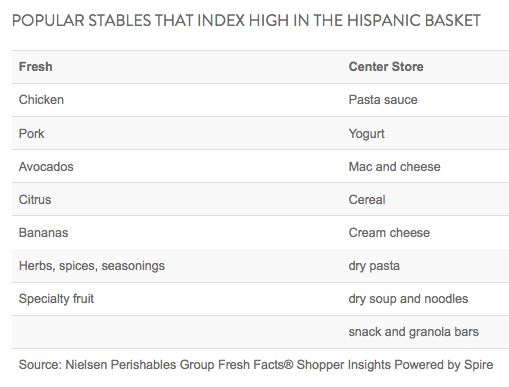A Fresh View of Hispanic Consumers [INSIGHT]
April 19, 2014
![]() Hispanics’ purchasing power is on the rise. By 2015, Hispanics will have $1.5 trillion in buying power, a staggering 50 percent increase from 2010. So where are they spending? In general, Hispanics place a high value on fresh foods. And they’re spending at a higher rate on groceries and shopping perishables more frequently than other consumer groups in the U.S. The need to appeal to this growing shopper base is clear, but understanding the influences of Hispanic shoppers and cuisine is far more complex. However, retailers who learn these shoppers’ preferences—particularly in the fresh foods space—will benefit as the group’s spending power continues to climb.
Hispanics’ purchasing power is on the rise. By 2015, Hispanics will have $1.5 trillion in buying power, a staggering 50 percent increase from 2010. So where are they spending? In general, Hispanics place a high value on fresh foods. And they’re spending at a higher rate on groceries and shopping perishables more frequently than other consumer groups in the U.S. The need to appeal to this growing shopper base is clear, but understanding the influences of Hispanic shoppers and cuisine is far more complex. However, retailers who learn these shoppers’ preferences—particularly in the fresh foods space—will benefit as the group’s spending power continues to climb.
Hispanic Consumers’ Fresh Effect
As a group, Hispanic shoppers typically spend a greater percentage of their income on groceries than non-Hispanics. And when it comes to what’s in this growing group’s baskets, fresh food matters. Hispanics shoppers spend $175 more on fresh foods per year at traditional grocery than the national average.
The perimeter departments (including meat, produce, deli, bakery and seafood) are important to Hispanic consumers for a handful of reasons. Many Hispanics consider fresh foods to be an indicator of quality and health. They also tend to prefer cooking from scratch and adding personal touches to dishes.
When it comes to the products in their basket, Hispanic shoppers tend to purchase fresh, minimally processed products whenever they can to incorporate as ingredients in their meals. Not surprisingly, the produce department’s inherently fresh and healthy qualities are a major draw. Of the five fresh departments, the highest-indexing items among Hispanic shoppers come from produce. And most are typically items that could be ingredients in a dish—including beans, guava and cactus leaves. Even in the meat department, the group’s focus on fresh remains strong. For example, chicken franks index high with Hispanic shoppers, likely due to the perceived healthy halo surrounding chicken, whereas cheese franks—processed cheese in processed meat—index low.
For many Hispanic consumers, meal preparation is all about “sazon,” or seasoning. This preference for seasoning food while preparing meals rather than buying pre-made explains why products like pork belly index higher with Hispanics than pre-seasoned pork products. However, Hispanics will occasionally seek out pre-seasoned products if they’re the right cut and flavor; for instance, pre-seasoned chicken thighs and chicken legs/drumsticks indexed high among the group.
Winning in Grocery with Fresh Hispanic Shoppers
While Hispanic shoppers made 5% more trips to traditional grocery in 2013 than the previous year, they spent less. Grocers still have the opportunity to increase their share of Hispanics’ wallet through fresh assortment, but simply stocking products commonly associated with Hispanic cuisine isn’t enough.
While many categories traditionally associated with Hispanic cuisine index high with Hispanic consumers, certain staples index much higher. For example, Hispanics purchase products commonly associated with authentic Hispanic cuisine—such as fruits like sapote, specialty cheeses and sweet goods—more frequently than other consumer groups, but these foods are “basket builders” rather than staples. Like other consumer groups, much of Hispanics’ shopping baskets include staples common to many consumers. Popular Hispanic staples include fresh chicken, pork, avocados, herbs and spices, as well as center store products like mac and cheese, cream cheese and dry pasta.

Winning with Hispanics at retail begins with knowing the shoppers and the products that are actually in their baskets. Understanding this interaction and leveraging the power of fresh can help better meet the needs of this growing consumer base and increase the share of Hispanics’ wallets.































